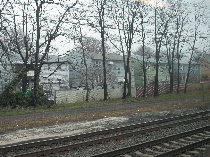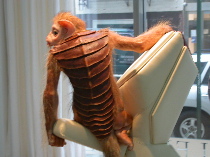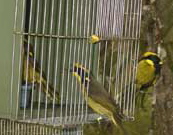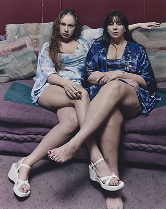
We took the train as I said, and wouldn’t you know, there was a delay. While stalled outside Elizabeth in the north Jersey bogs we had the opportunity to absorb the lay of the land beside the tracks — stringy-looking trees, fences, tract housing and telephone polls.

It was the first forlorn moment in a day that had a lot of those. We saw much art that was either forlorn or fantastical (the antidote for forlorn?). Some pieces dipped so far into fantasy you wondered if the artists too had been moored in a bog and were looking for a way out.
Libby will tell you about some of what what we saw. Here’s the beginning of my bit — a few initial thoughts and some images.
Patricia Piccinini’s sculptures at Robert Miller Gallery were of two types — sci-fi Hollywood fantasy and car-culture fantasy. Either way, you get a lot of fantasy and a longing for a better world in her gorgeously-made pieces.

Piccinini’s piece (detail, front and back) “Bodyguard (for golden helmeted honeyeater)” fascinated, repulsed and mesmerized. The sculpted creature, imagined and created by the artist is a facsimile of an animal that would protect an endangered bird from her home state of Victoria in Australia. It’s a believable creature on one level — the craftsmanship astonished — and the little monkey could be right out of a Natural History museum. However, the whole scene is a complete fiction. The monkey sits on a leather-upholstered “tree.” And in the corner is the endangered bird — in a scene on a video monitor.

The bird goes backwards and forwards most unnaturally in the video loop which makes you wonder whether it, too, is a fiction. (It’s not — image shows birds released into the wild in Victoria after being bred in captivity. Read about the bird.) What is most real in the piece is the sense of longing for a better world, one in which genetics could be used to help us all out of the eco-mess we seem to be sinking into more and more.
Piccinini, an Australian artist who was Australia’s representative at the last Venice Biennale, uses the same technical crew and assistants that Ron Mueck uses (he of the three-quarter size nude figure of his dad (“Dead Dad,” image) that was in the “Sensation” show at the Brooklyn Museum in 2000). That explains the amazing craftsmanship, which exists in Mueck’s work as well.

“Bodyguard” is part of the artist’s series,”Nature’s Little Helper,” a wry title that implies child’s mimicry of a parent. If humans are indeed Mother nature’s little helpers we’ve got to grow up a little and take charge. Wishful thinking? An impossibility? The piece is escapism on the order of a Hollywood movie.
This is the artist’s first solo show in America. I can’t wait for the next one.

Alec Soth’s photographs at Yossi Milo have forlorn as subject matter. Soth, whose approach is documentary tinged with a little Arbus and Mary Ellen Mark presents people and places as mood pieces — archetypes that trigger reactions. Libby felt there was creep show in the work and I see how you can get that.
I think the photographer’s got some empathy with these people. These are icons — the aging girl sitting on a bed with Disney character bedspread; the mother and daughter look-alikes with their entwined legs (image); even the guy in jockey shorts with the Rotweiler between his legs — but the level of intimacy with which they’re captured shows their humanity and the photographer’s as well. And what it communicates to me is that we’re all a little off, in our own ways. Mark and Arbus did it before him, but Soth is mining a photo-tradition, the edgy, telling portrait that speaks about culture, identity, and vulnerability.
Scale is everything and Soth’s works were small scale here compared to the mural sized photographs he has in the Biennial. The bigger ones had more oomph but these work well.
Piccinini’s piece, which is a believable monkey sized critter, also works well. Any larger and it would have been too fantastical.









